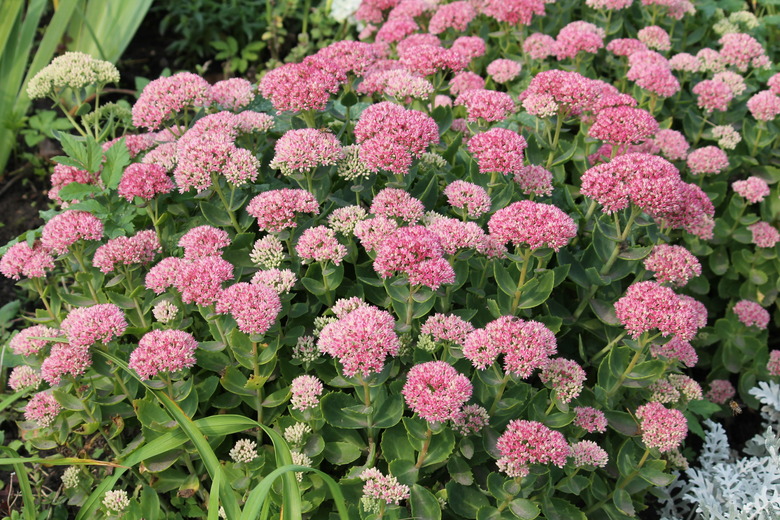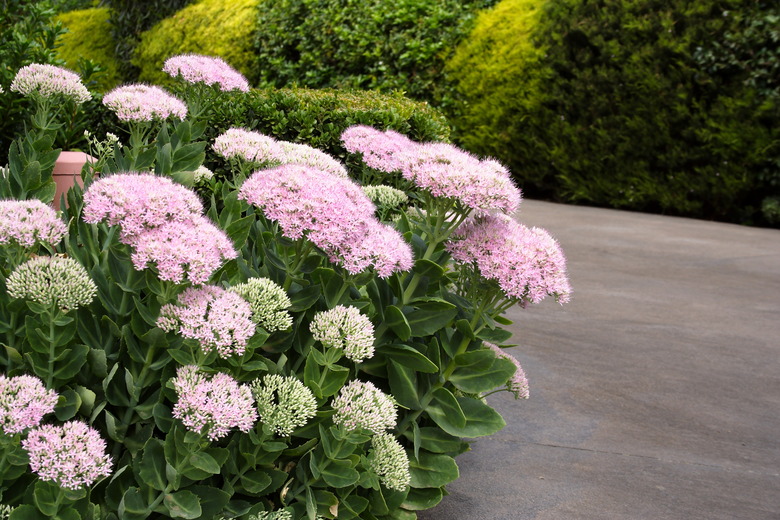How To Grow Sedum (Stonecrop)
We may receive a commission on purchases made from links.
What's as easy to grow as a stone? One answer would be sedum, a group of perennial succulents in the Crassulaceae family that includes more than 400 different species in different genera. Although some types of sedum plants are still in the Sedum genus, others have now been reclassified into different genera, including the Hylotelephium genus and Phedimus genus. These plants grow in clumps or creep along the ground, and the creeping varieties are so easy to grow that they're also commonly known as "stonecrop."
Where Does Sedum Grow Best?
Where Does Sedum Grow Best?
Many sedum cultivars, such as Dragon's Blood (Phedimus spurius 'Dragon's Blood,' formerly Sedum spurium 'Dragon's Blood'), are hardy in U.S. Department of Agriculture plant hardiness zones 4 through 9, but a few, such as Brilliant (Hylotelephium spectabile 'Brilliant'), Autumn Joy (Hylotelephium 'Herbstfreude' AUTUMN JOY) and Purple Emperor (Hylotelephium telephium 'Purple Emperor'), are winter-hardy to zone 3. Sedum will die back in the cold winters of the Northern zones, but it usually recovers in the spring, and after you remove the dead growth, it will regain its vigor and produce flowers as the spring turns into summer.
Most types of sedum are native to North America, and you'll find them growing in barren crevices in the Rocky Mountains and poking out from boulders as well as creeping along outcroppings in arid desert regions. The moniker "stonecrop" probably refers to the fact that sedum can grow on stone, but it also suggests that growing it is dead easy, which it is.
Although most sedum species can't tolerate the extreme heat of zones 10 and warmer, a few that are native to Mexico, including Sedum oxypetalum and Sedum praealtum, will grow in zone 11, as will Sedum sediforme, which is native to the Mediterranean.
When Should You Plant Sedum?
When Should You Plant Sedum?
Whether you plant sedum in store-bought pots or you sow seeds directly into the ground, the best time to do it is in the spring after all danger of frost has passed. If you choose to start seedlings indoors, you want to give the seedlings time to grow and harden them off before they go outside. The seeds take from 14 to 21 days to sprout under grow lights or on a windowsill and another six to eight weeks to grow large enough for transplanting, so you should sow them a good eight to 10 weeks before the last frost.
Using Sedum in the Garden
Using Sedum in the Garden
It goes without saying that a drought-tolerant succulent like sedum is a shoo-in for admission to your xeriscape landscape, as it will grow happily in gravel mulch and in rock gardens and will even inhabit the crevices in rock walls to provide texture an color. Because it requires so little maintenance, it's a common ground cover in landscapes, and the upright varieties grow just tall enough to work as foundation plantings. Sedum grows well in containers too, so you can enjoy it even if you don't have a garden.
Sedum likes full sun, but it's just as tolerant of shade as it is of drought. You can grow the creeping varieties, which are the most shade tolerant, in parts of the garden where few other plants will grow. If it should happen to creep into a sunny part of the garden, there's no problem because sedum is also tolerant of direct sunlight; about the only thing sedum can't tolerate is excessive moisture, so you must grow it in well-draining soil. The sedum plant is an example of nature's honing its survival skills to the maximum.
Upright sedums can reach a height of 1 to 3 feet and form a clump of thick, fleshy greenery that look for all the world like broccoli clumps — that is, until the flowers bloom and adorn the garden with color. Rather than dying off or going dormant in winter, many types of sedum become more visually interesting as the colors deepen, with foliage that often remains vibrant throughout the winter. During the summer, both upright/clumping and creeping sedum attract bees, butterflies and hummingbirds and provide a steady supply of cut flowers for the table.
Adding Companion Plants
Adding Companion Plants
A few other plants thrive in less than ideal conditions and make good companions for sedum. Among them are asters, with small and multicolored flowers that have the same starlike nature of sedum flowers, and chrysanthemum, whose oversized blooms make a pleasing contrast. Purple cornflower (Echinacea purpurea) can also grow in sun or shade, although it needs a bit more water than sedum if exposed to full sun. Its spiky stalks create a defining framework for the lush greenery of sedum cultivars such as Autumn Joy throughout the fall.
Starting Sedum from Seed
Starting Sedum from Seed
The most common way to plant sedum is to use starts purchased from a garden center or an online source, but you can also grow sedum from seeds started in containers or directly in the garden. Seeds need light to germinate, so they should be sown directly on the ground and covered with a thin layer of vermiculite to protect them from birds. When germinating seeds in containers, fill pots with a well-draining cactus mixture, and when sowing seeds outdoors, prepare the soil by turning it to a depth of 6 to 12 inches.
Transplanting Seedlings and Starts
Transplanting Seedlings and Starts
When transplanting potted seedlings or planting store-bought starts, choose a location with full sun and good drainage and space the plants from 6 inches to 2 feet apart depending on the species. Dig a hole large enough to accommodate the root ball, remove the starts from their pots and remove dirt from the root ball with your hand to separate the roots. Set the root ball level with the surface of the ground and backfill. Then, apply a layer of mulch to protect the roots and retain moisture.
The addition of compost to enrich the soil is always a good idea, but it's optional when planting sedum because the plant can grow on almost any soil type. Choose a cloudy day for planting to minimize the effects of transplant sock. Transplants need a good watering to get them going, but once the plants get established, they need very little water.
Dividing and Propagating Sedum Plants
Dividing and Propagating Sedum Plants
Besides growing sedum from seed and from store-bought starts, you can also divide sedum plants and plant them in other parts of the garden. In fact, division is healthy because sedum clumps tend to get overgrown over time and need to be thinned. To divide a plant from a clump, dig around the root ball to expose the roots and then cut the plants you wish to extract with a sharp, alcohol-sanitized garden knife. Dig a hole for the divided plant and plant it as you would a store-bought start.
You can also easily grow sedum from cuttings. Simply cut a stem from an existing plant, place the cut end in the soil and water well until it gets established. As long as the cutting has enough light and air circulation, it should quickly take root.
Caring for Sedum
Caring for Sedum
Sedum grows best on loose, well-draining soil and little soil preparation is needed other than to loosen it by turning it to a depth of 6 to 12 inches. Because it has a propensity for stem and root rot, sedum should not be planted in compacted or clay soils, or in a low-lying area of the garden in which water collects. Like most plants, sedum can benefit from the nutrients provided by compost, but it will do fine without it. In fact, the clumping varieties that grow upright can get top heavy and closed in if the soil has too many nutrients, especially nitrogen.
Young sedum plants should be in full sun, but as they mature — particularly the creeping varieties — they are able to handle some shade. In general, plant sedum in a sunny location, but don't be concerned if that location becomes shaded by larger plants later in the season. Sedum is extremely drought tolerant and needs watering only when the soil has completely dried out.
Like all succulents, sedum stores water in its leaves and stems, so it handles drought conditions easily, and in fact, you can do more harm by overwatering than you can by neglecting it. Leaves on some plants have a bluish-green tinge, while some plants sport variegated leaves. The five-petaled, star-shaped flowers can be yellow, white, pink, or red. Sedum is so tough that you can actually trim the spent flowers with a string trimmer without doing any significant damage to the plant, which will happily continue producing new growth.
Harvesting Sedum Seeds
Harvesting Sedum Seeds
If you want to harvest seed from your sedum to plant more next year, wait for the flowers to wilt and turn brown. Then, cut them off into a paper bag and set the bag aside to allow the seed heads to dry. When they are dry, set a screen or fine-mesh colander over a bowl and thresh the seeds over the bowl, allowing the small, thin seeds to fall through the screen while the rest of the debris collects on top. Set the seeds in a dry place for planting next spring or put them in the refrigerator, where they will keep for up to a year.
Winterizing Your Sedum
Winterizing Your Sedum
Sedum overwinters in most growing zones in which it is hardy, but to prevent old, dead growth from interfering with new growth in the spring, cut it back to ground level. Leave any foliage that is healthy and green for winter color.
Monitoring for Pests and Other Problems
Monitoring for Pests and Other Problems
Sedum leaves are not as attractive to insects as those of many other plants, but with all the water they contain, you'd expect the leaves to interest at least a few pests, and they do. Aphids, which are found on virtually all foliage, and mealybugs will congregate on the leaves (aphids prefer the underside), suck the juices and leave sticky secretions that promote mold growth. You can rinse them off with a strong jet of water.
Slugs and snails can also do a lot of damage, eating large holes in the leaves at night when you're watching the news. You may be able to reduce their population by turning off the TV and going outside with a flashlight to hunt them down. A beer trap, which is a glass or shallow bowl half-filled with beer set into a hole in the ground, is also an effective control mechanism. Spreading diatomaceous earth around the plants also works by killing any slugs or snails that slither over it.
Diagnosing and Treating Diseases
Diagnosing and Treating Diseases
Apart from stem and root rots, which occur when the soil is too wet, sedum experiences few diseases, and the ones it's most likely to contract are caused by fungal infections. Botrytis leaf blotch is a mold that affects leaves and flowers, causing them to wilt and die, and powdery rust is a fungus that forms unsightly blotches on the underside of leaves. Sterilize your cutting tools and remove affected leaves and flowers. In severe cases, spray with a copper-based or sulfur-based fungicide that's labeled safe for succulents.


